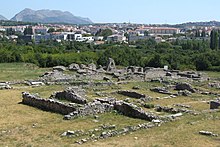Solin
| Solin | ||
|
||
|
|
||
| Basic data | ||
|---|---|---|
| State : |
|
|
| County : |
|
|
| Height : | 0 m. i. J. | |
| Area : | 18.37 km² | |
| Residents : | 23,926 (2011) | |
| Population density : | 1,302 inhabitants per km² | |
| Telephone code : | (+385) 021 | |
| Postal code : | 21 210 | |
| License plate : | ST | |
| Structure and administration (status: 2013, cf. ) |
||
| Community type : | city | |
| Structure : | 3 districts | |
| Mayor : | Blaženko Boban ( HDZ ) | |
| Postal address : | Stjepana Radića 42 21 210 Solin |
|
| Website : | ||
Solin ( ˈsɔliːn , Italian Salona ) is a small town with 23,926 inhabitants (2011 census) in the Croatian county of Split-Dalmatia . The Latin name is said to go back to Illyrian names, analogous to other settlements in the area with the ending -ona . It is located on the Adriatic coast at the mouth of the Jadro River and now borders directly on the city of Split .
Attractions
- Ruins of the Roman forum with temple and theater
- Remains of the Roman Porta Caesarea and the city wall
- Amphitheater ruins (2nd century)
- Remains of early Christian churches
- Remains of a Roman and early Christian cemetery (Manastirine) and a monastery
- Branch of the Split Archaeological Museum
history
In historical times, Solin was much more important than today's small town.
Originally a fortified port city of the Illyrian Delmaten , Salona became in the 4th century BC. Taken by the Greeks . The town was strategically located on the Jadro River at the intersection of the coastal road and a road inland across the Klis Gorge .
Julius Caesar raised Salona in the middle of the 1st century BC. BC to the rank of a Roman colony ( Colonia Martia Iulia Salona ) and made it the administrative center of the entire then province of Illyria (later Dalmatia ). Through the Roman emperor Diocletian , who probably came from Salona himself, the city received the emperor's family name as an honorary title: "Valeria". The last legitimate Western Roman Emperor Julius Nepos resided here from 475 to 480 .
Between the 4th and 6th centuries Salona was an important center of early Christianity, as evidenced by many archaeological sites. At the height of development, the city is said to have had roughly three times the population of today's city. At the end of the 5th century Salona became part of the Ostrogoth Empire under Theodoric . In 535 the Eastern Roman general Mundus conquered the city for Emperor Justinian .
In the early 7th century Salona was conquered by the Avars and Slavs . No contemporary source reports the fall of the metropolis of Dalmatia. Around 600 Pope Gregory was still in contact with the city to clarify a church issue. According to coin finds and the interpretation of later sources, Salona was likely to have fallen between 611 and 626. In the year 640/41 prisoners from Dalmatia were ransomed, which suggests a later date of the conquest. After that, Solin lost its importance to the neighboring city of Split . From around the middle of the 7th century, almost all of the population had withdrawn there.
In the interwar period , Solin was still a place where a popular fair was held.
Personalities
- Nikola Moro (* 1998), football player
Individual evidence
- ^ Walter Pohl : The Avars, A steppe people in Central Europe 567–822 AD . 2nd edition Munich 2002, ISBN 3-406-48969-9 . (P. 67, p. 243)
- ^ Franz Werner: Autumn trip to southern Dalmatia. In: Reichspost , October 12, 1929, p. 1 f. (Online at ANNO ).



